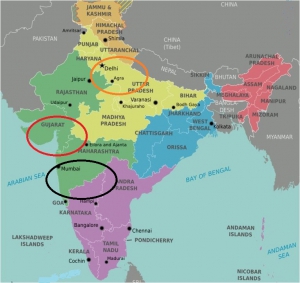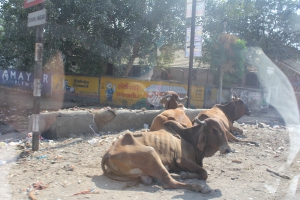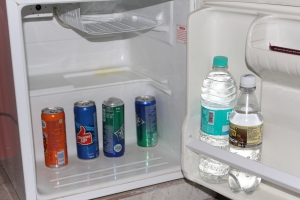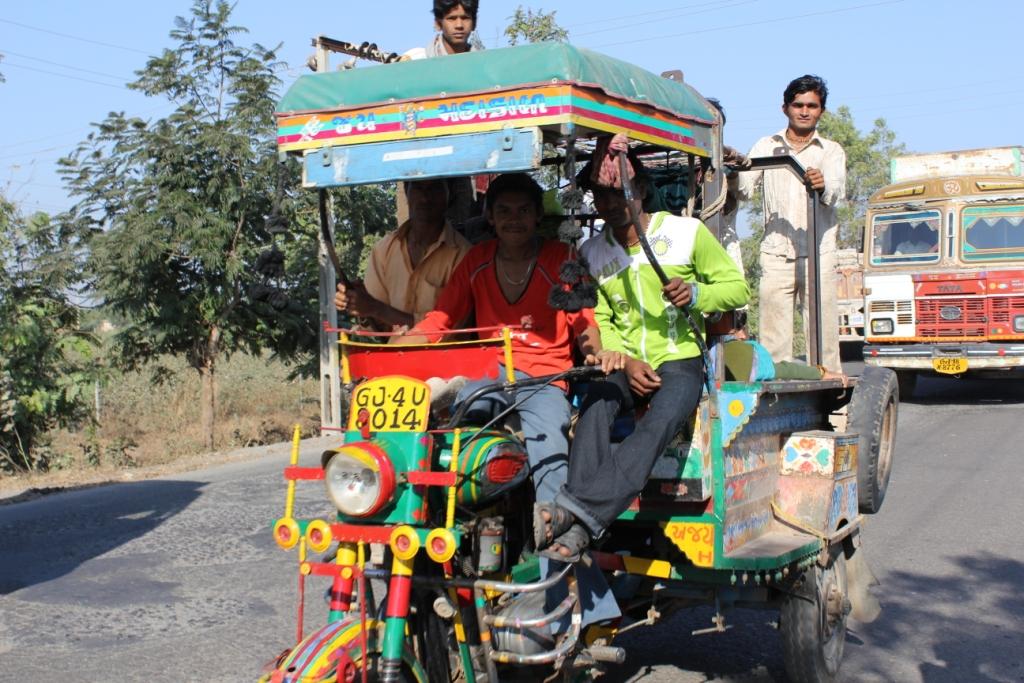From Mumbai to Bhavnagar in Gujarat: an impressing journey with a lot of colorful pictures. Travelling around India: from Delhi to Mumbai. Having the first cultural shock in the Indian Metropole. Afterwards in Bhavnagar: 600 km apart from Mumbai, rural area. Again a cultural shock: poverty in onion country.
In Gujarat
We are on the airfield in Bhavnagar/Gujarat, the airport building located at a distance, so we take a small walk. The landscape looks emaciated and dry. No trees. Our driver and our translator are already waiting for us. Driver and translator? The car is too small. So we needed a second one. For the luggage. Two silver jeeps in a convoy: not at all inconspicuous in the streets of colored “Toeff-Toeff”, overloaded motorcycles or colorful trucks transporting people on their cargo area. We go from Bhavnagar in direction Mahuva, alongside the coastline.

On the way to Mahuva
On the left and on the right, big companies, oil-treatments, steel factories. Gujarat, explains our translator, subsists on ships-breaking-industry – breaking up of wrecked ships. Because the Indian wages are so much lower than in China, old ships from all over the world are wrecked here. Ships are welded asunder, steal is reworked, the remaining oil sucked away and processed. What a fortune for the industry: At a high tide, the old ships can drive to the coastline and at a low tide they could stand already in the dry dock, if one can name that at all. The working conditions are very poor, wages are low, no protective cloths, and thus, there are a lot of work related accidents. But nevertheless, many migrant workers come from even poorer regions to look for work here.
We drive through a mixture of dust and exhaust-gases on roads which exist of more potholes than asphalt. Roads without fortifications, narrow and poorly upgraded. We would only drive in a single lane – in India, there are three lanes to drive in the minimum. Regular traffic takes place on the left and on the right side of the road, overtaking takes place in the middle lane. You drive quickly, slow cars or ox cars consequently have to be overtaken – commencing with a loud honk! On some back sides of trucks, you are expressly asked to honk if you like to pass. There are no pavements; people are just walking on the roads. This is simply more exciting for drivers passing! Especially during night.
In India you are left-hand driver. To runaround the road holes, drivers often choose to go on the right side. But when two vehicles meet, suddenly both decide to go back on their originated lane (leftside).
Those are rather exciting moments for cautious Europeans leaving us on the verge of a nervous breakdown. We continue to go south – streets are less crowded now, people seem to be much poorer than in the cities. We drive alongside unpaved country roads – alongside the cotton fields. Children are working in the fields. Ox cars transport people together with big jute bags on their backs.
Agriculture
Agriculture contributes 30 % to INDIAN GNP, but two third of the population works in it. The climatic conditions are very favorable: tropical and subtropical conditions to grow various plants such as coffee, tea, rice, starch, peanuts, onions and spices. More than 43 % of land is used for agriculture. And India is ten times bigger than Germany.
There is a lot of poverty in small villages, humble huts along the road; sometimes we see rudiment huts in the fields. Pale and skinny people. Overweight? Impossible. India is member of BRIC countries – like Brazil, Russia or China. But India is poorer. With an explosion of population – every year! More than 1, 2 billion people live here, thereof 25 % in poverty.
One study of the National Council for Applied Economic Research (NCAER) found out Gujarat is one of the most affected Indian regions for hunger. Danger of hunger in Gujarat is higher than in Tamil Nadu or Western Bengali, even higher than in Uttar Pradesh, the poorest region of India.
We learn a little more about that on our way alongside Gujarat, the Onion Country of India. India is – apart from China – the second biggest Onion Grower. Gujarat is number five region for onions in India, harvesting also cotton, onions, garlic and peanuts. In Gujarat more than 1, 8 Mio tons of fresh onions are grown . Most of them for domestic consumption. There are 65 onion Processors in Mahuva, approximately 15 specialized to export dehydrated onions
One of our partners is processor and exporter and a little bit obese. Unlike than in German, overweight is a sign of wealth in India.
Only 15 % of onions are exported. If the price of onions rises, Government will express an export ban and a prohibition to process onions. If onion price decreases, government can incentivize exports to take the goods from the domestic market. Government is doing so to prevent from civil war or revolts.
Dehydration
It is December, shortly before crop. Time for maintenance of machineries to prepare the forthcoming season.
Unlike pepper, onions are not cash crops: they have to be sold immediately after crop, because of their limited shelf life. (See our second SPICE LETTER article) The farmers sell their onion mainly traded in the local markets.
Pepper, harvested in the South of India, will be dried and stored by the farmer. The farmers decide when to sell the pepper to the middleman – today or later, when prices will be better.
Only 15 % of the Indian onions are exported – fresh or dried as onion powder, onion flakes or onion kibbled. To process the goods, onions have to be cleaned, peeled, dried, cut, milled and sieved. Some of the suppliers can use a SORTEX machine (an optical cleaner). The machine is an Indian model. Some also have metal detectors.
Productions are simple but clean. Iso-certified. We learn: European customers are quality buyers. American customers are price-buyers. Aha.
Indian producers do not use a lot of techniques – we do not see any transport belts or fork lifter, consequently no pallets, too. Too expensive. Loans are cheap. We calculate: an Indian worker gets approx. 270 rupia per day –approx. EUR 3,90. It is much cheaper to stack the bags manually than to use a fork lifter. Even if you get the fork lifter cheap – there would be nobody who could drive him. Not to mention the costs for maintenance and spare parts.
Fifty Kilometres in 90 Minutes
It is late. We go by car – 50 km in one and a half hour – to the next and the best hotel in place. Unpaved roads, dusty. It is already dark. People are scampering out of nowhere in front of our headlights. Streets are narrow, loud and dirty.
Dirt everywhere: plastics, packaging, bottles. Nobody cares. There is no local waste collection. when there is too much rubbish, some people are going to burn it – next to the road. Heavy smoke and stench from burning in the heat: tears come into my eyes.
Next to the road: cows. Eating rubbish. Not every cow is a holy one. Sometimes people need cows for working in the fields. When coming back I will never eat beef any more.

Our hotel is state-owned. The staff is excited, because of us. Europeans are very seldom in this country side. There is a small quarrel between the employees to decide, who carries our luggages. Because of the tip. Check-in was very complex and lengthy. Where did you come from, what was the last hotel you stayed in, where do you go, when are you going to leave India.
We moan: let’s have a cool beer! The guy from the hotel, who won the battle to carry our luggage, shows us our hotel room. He is proud: air-condition, big bathroom, minibar. He is proud working in this “Luxury“hotel.
After he gets his tip, he leaves the room and we open our minibar (a beer?) We discover four tins and some bottles of water. Two Sprites and two others. Out of date since half a year.

One of the tin curved a little bit and looked slightly explosive! No thank you! We refrain to open it.
Our next way to the restaurant is disappointing again. No beer! Prohibition. Gujarat lives without alcohol. Mahatma Gandhi, who comes from Gujarat, detests alcohol. Furthermore, many people are Muslims in Gujarat. So there is no way to get even one beer – not even after a tiring day. No wonder that the cuisine in Gujarat is mostly vegetarian – there are not many meat dishes to order.
The next day we continue our audits again in the southern direction. The same road. The same way. Again 1,5 h on a bad road. And then we recognize: the today’s supplier we want to visit today is only 500 m next to the yesterday’s supplier! As all other suppliers from Gujarat. Nearly all of them are located on the same road. The reason is, our translator explains with a smile on his face, there was no adequate hotel for Europeans here. So we had to travel in the north for one night and to come back again in the south today.
One day later, we finish our audit tour. In the airfield of Gujarat airport, where we wait to climb the gangway of our airplane to Mumbai after a last pass port control. The next location: Cochin, south-west of India at the Malabar cost . A prosperous region. Fertile, green – the spice gardens of Indian. We will enjoy it after those exhausting days!





